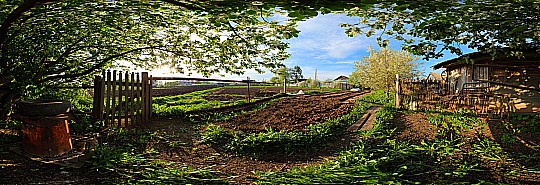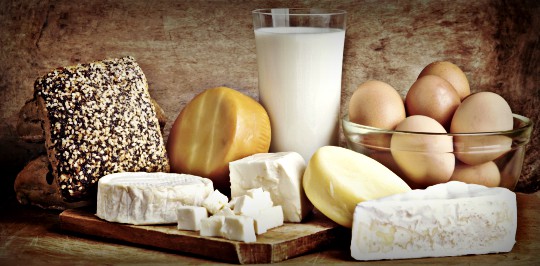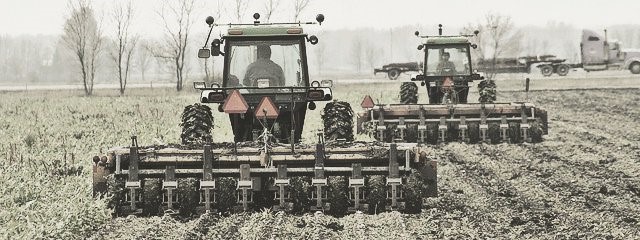
An Ultimate Guide On How To Make Money With Land
Because God’s NOT making more of it, right?
That’s why it’s such a valuable asset if you use it properly.
You can use the money to either:
- Offset the cost of ownership OR
- Generate an income stream…
So today, I’m going to share all my best ideas on how to make money with land:
TOPICS IN THIS GUIDE… ↓(click to jump)
- Intro & Overview [with Video]
- Using Agricultural To Generate Cash
- Using Land To Raise Livestock
- Harvesting Livestock Byproducts
- All Your Land Rental Opportunities
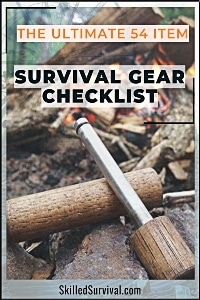
Want a free 54 item survival gear checklist?
Click here to instantly download this Complete Checklist PDF. No purchase necessary.Introduction & Overview [with Video]
After months of searching, imagine you finally find the perfect piece of land.
Yay! Good for you!
But what if the cost to own the land takes up most of your savings, even worse, all of it?
What can you do to offset the cost?
Well…lots actually.
There are several ways you can pay for your land from your land.
Watch this is an excellent video that summaries most of the land uses covered in this article:
↓ How To Make Money On Your Land | Rent, Tillable, CRP, Timber
How To Make Money From Land: Agricultural Options
1. Fruit and Vegetable Gardening

This is also a smart way to make some extra income.
Just double (or triple +) the number of fruits and vegetables you are growing for yourself and take the rest to a local farmer’s market.
Here are some hardy plants that you can grow almost anywhere.
- Sturdy Summer Vegetables: Amaranth, Asparagus, Eggplant, Peppers, Okra, Sweet Potatoes, Tomatoes, and Summer Squash
- Sturdy Winter Veggies: Carrots, Spinach, Leeks, Collards, Parsnips, Lettuce, Cabbage, Turnips, and Swiss Chard
With homestead survival, gardening will be one of your most renewable resources.
You can use it to feed yourself and your livestock.
You could also use it to sell the produce and the seeds. If there is anything left over, use it for compost.
If there is anything left over, use it for compost.
Successful gardening is necessary if you plan on living and making money off your land.
So pick up The Vegetable Gardener’s Bible (it’s a 4.8/5 star book with over 500 reviews).
↓ Vegetable Gardener’s Bible Book Review
2. Harvesting Wild Plants
Each piece of land will have its own hidden gems.
Some may be abundant in wild edibles and others with timber or a stream filled with fish.
Maybe your land naturally produces edible mushrooms.
The key is to decide which of the resources your land is rich with.
Make sure to survey your land thoroughly for these hidden gems, as they might add some surprising cash opportunities.
3. Grapes for Wine/Alcohol
Wine and alcohol can be a very profitable way to earn extra income on your land.
Depending on the type of alcohol you decide to produce, there are many first aid uses, which will come in handy living off the grid.
Other alcohol and wines make a tasty treat for you and a popular commodity to others.
*Making your own alcohol without proper knowledge can be dangerous as the alcohol content can rise to dangerous levels.
Please do additional research before attempting this method.
Here’s our recommended resource to help start making money with grapes: The Backyard Vintner.
↓ Starting a Backyard Vineyard
4. Holiday / Seasonal Opportunities
Christmas tree farms and pumpkin patches.
These highly depend on how close you are to a city’s population.
You’ll also want to research how much competition there is.
However, this could be an excellent money-making idea if you do your homework and it checks out.
Plus, it limits your land’s exposure to “strangers” for very few days.
Sure, you might have hundreds or thousands of city slickers visiting your land.
But it will only be for a month or so out of the year.
If you scale the opportunity up large enough, you might be able to live off this income for the remainder of the year.
It’s a very lucrative setup for many survivalists and homesteaders.
↓ Starting a small acreage Christmas tree farm
↓ The Patch: Overview of the process of growing pumpkins for agritourism
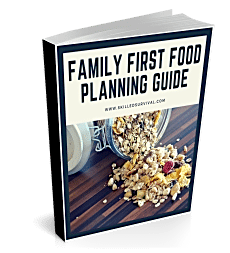
Want a free family-first food planning guide?
Click here to instantly download this Complete Checklist PDF. No purchase necessary.How To Make Money From Land: Livestock Options
Livestock creates an ongoing protein food source for survival and more income to buy items for stockpiling or bartering.
Here are the most popular homestead livestock options:
5. Cattle
First, you must decide whether you will raise dairy or beef cattle.
The difference is significant.
Dairy cows are raised for milk, and beef cows are raised for meat.
Both types of cows will eat 3 to 6 percent of their body weight daily, depending on whether they are lactating.
Cattle can graze from late spring to late fall if you have a healthy pasture.
If the field runs short of grass, you can feed them hay, grains of corn, oats, wheat, and barley.
However, you must carefully plan to grow these winter feeding options or spend significant money buying them.
Extra vitamins are also necessary to maintain your herd’s health and are costly.
Cattle can drink up to 18 gallons of water on a hot day, so a fresh, abundant water supply is essential.
You may need to invest in water wells on your homestead to supply ongoing water needs.
You may decide to have a few beef cows and a couple of dairy cows.
With both, you can benefit from milk, cheese, and meat for yourself and help diversify your income.
If you decide on a dairy cow, you must be dedicated to milking her daily, without exceptions.
Investing in a proper milking machine will help you be consistent.
Each cow will need two to five acres and a sturdy six-foot-high fence.
So, if your homestead is small, you may consider raising goats as an alternative.
Here’s our recommended resource to help start making money with cattle: Guide To Profitable Livestock.
↓ 5 steps to start your small livestock farm
6. Goats
Goats can be a great source of milk when you’re strapped for space.
However, they are more sensitive to their surroundings than cows.
They are highly sensitive to wind and water quality and need shade available at all times.
As with dairy cattle, dairy goats must be milked once a day, no matter what.
Goats should be fed a diet similar to cows’, grazing the pasture, hay, and vitamins.
They will eat two to four pounds of their body weight a day.
They will drink up to three gallons of water daily unless they are grazing.
If they are grazing, they get most of their water from the grass they eat.
They are also highly sensitive to poisonous plants like allspice, poppy, parsnip, hemp, stagger grass, and buckwheat.
They will need at least a 36 to 70-square-foot covered stall.
If you have more than one, which is suggested, a 70-square-foot stall will be needed.
Goats may take up less space than cattle but are very sensitive creatures.
If you choose to have them as livestock, you will need to allow additional time in your schedule to care for them.
Our recommended resource to help make money with goats is Guide To Profitable Livestock.
↓ Learning To Goat Farm!
7. Chickens
Chickens can provide a good protein source for you and an easy sell at the local farmer’s market.
If raising chickens for eggs, you should have a steady flow of one egg each day per chicken.
If you allow the chickens to roam free will help you cut down on weeds and help fertilize your
Win, win.
Of course, if you want to raise chickens, you’ll need to know how to build a chicken coop.
↓ Raising Chickens: Everything You Need To Know!
8. Pigs
A full-grown pig can give you a hearty meat supply for sale, trade, or to feed your family.
Pigs will grow fast when feeding them a steady supply of table scraps, lots of corn, extra vegetables, and fruit.
While chomping down the 6 lbs. of food required daily, they will create 1.5 lbs. of waste.
Now that’s a lot of manure!
You should save manure for your garden and crops.
For the rest, have another local farmer or gardener lined up to buy the remaining manure from you.
A pig’s manure alone can provide you with a steady supply of cash if you play your cards right.
When building your pig pen, remember that it should be twice as long as it is wide; each pig needs 50 square feet.
Keep their water at the opposite end of the pen from their food.
They usually defecate near their water supply.
The pen should also be partially sheltered because pigs can burn easily.
You will also want them to be able to find shelter if bad weather comes in.
Consider a mud wallow, as pigs have difficulty regulating their temperature.
As the pig ages, you will want to keep an extra eye on its weight.
Some pigs will stop gaining weight no matter how much you feed them.
This is the first sign they are ready for the table.
Once the pigs are 280 lbs. or more, it’s time to take them to the butcher and cash in on the meat from your pig.
Here’s our recommended resource to help start making money with pigs: Guide To Profitable Livestock.
↓ Raising PIDS for BEGINNERS! [In-Depth Guide]
9. Turkeys
You should buy your poult (baby turkey) from a reputable breeder.
A good breeder will cut down on possible illnesses.
You can buy a poult for less than a dollar each.
Although they are inexpensive, their additional needs are not.
Turkeys are extremely sensitive animals at the start of their life.
You will likely lose a few from your flock in the first few weeks.
Before you get your poults, you must clean the battery (housing system for raising turkeys).
Completely disinfect the entire unit.
You will also need to purchase a 100-150 watt clamp-style lamp.
This will help keep their nest around 100 degrees in the first week.
After they survive the first week, you will gradually lower the heat each week.
They won’t need an extra heat source when you make it to week ten.
When feeding your poults, provide plenty of feed mash and freshwater.
Once the turkeys reach the maturity of fourteen weeks, they are ready for the marketplace or your table.
A grown turkey weighs around 35 lb. to 45 lbs.. making a few good meals for you and your neighbors.
Here’s our recommended resource to help make money with turkeys: How To Raise Turkeys.
↓ Wanna raise turkeys? Watch this first!!
10. Tilapia Farming
Fish farming can be very lucrative in certain climates, and you can harvest tilapia every 6 to 9 months, depending on the species.
So, if you have a pond already on your land, you are set!
If not, maybe you’d better start digging.
The simplest way to raise tilapia is by building a cage that will stay in your pond.
With some plastic piping, sturdy netting, and fingerlings, you have a great fish farm to help you survive year-round.
“OK, but where do I get the fish to start farming?”
Some websites sell live tilapia specifically to fish farmers, like Lakeway Tilapia,
Buying them from a notable fishery gives you the peace of mind that the fish you receive are top quality.
This means disease-free.
You will also be able to get the right male-to-female ratio for mating.
Here’s our recommended resource to help start making money with tilapia farming: Tilapia Farming Guide.
↓ 10 Mistakes I made raising tilapia and catfish
11. Beekeeping
These little guys will not only help you satisfy your sweet tooth with honey, but they will also pollinate your
Getting a basic bee starter kit is the easiest and fastest way to start.
Your kit should include:
- a hive tool
- smoker
- frames
- feeders
- hive body and stand
- queen excluder
- inner/outer cover
- honey supers
- cotton/poly overalls with attached zipper veil
- mesh helmet
- and vented leather gloves
Next, locate where you would like your hive to be located.
If you put your hive within a quarter-mile of your
Now, pick your bee! There are many races of bees, and each has its strengths and weaknesses.
So, do your research before you decide which honey bee will be best for you.
Once you pick your bee, you’re ready to get started.
Sit back and enjoy the honey.
Our recommended resource to help make money with beekeeping: Beekeeping For Beginners.
↓ Becoming a Beekeeper – Day 1 till Day 365
12. Raising Rabbits
Before you start buying rabbits, get some rabbit hutches ready.
Rabbits are notorious escape artists, so ensure your hutches are 100% secure with no gaps or holes.
The one pro with raising rabbits is they are relatively easy to breed compared to other livestock.
They also don’t take up much space.
So this means you can raise a lot of rabbits quickly in very little space.
However, the downside of raising rabbits is that the equipment necessary to get started can be expensive.
Also, rabbits are not meat that is currently widely consumed in our culture in mass, so you may not get a lot of money for your rabbit meat.
In survival turmoil, tho, rabbit meat would become a major source of protein, widely accepted and enjoyed.
Here’s our recommended resource to help start making money with rabbits: Guide To Profitable Livestock.
↓ 4 Big Reasons I Have Rabbits/How Rabbit Farming Started

Want a free 78 item prepper checklist?
Click here to instantly download this Complete Checklist PDF. No purchase necessary.How To Make Money From Land: Livestock Byproducts
If you’re trying to raise and keep livestock, it only makes sense to receive every animal benefit. Milk, eggs, cheese, and manure are popular commodities.
13. Milking A Cow
A dairy cow must be milked daily but can produce two to six gallons of milk.
That’s a lot more than most families can regularly consume.
So ensure you have plenty of room for refrigeration or customers ready for delivery, as it adds up fast.
Start by securing your cow to a post.
Clean the cow’s teats with warm, soapy water.
This will prevent bacteria from contaminating the milk.
Dry the teats by gently patting them with a clean cloth.
Sitting next to the cow, place a milking bucket under the teats and secure it by putting your foot on either side.
You may choose to apply Vaseline to your hands to reduce friction.
Wrap your hand around the base of two teats. Squeeze downward to push the milk out using your thumb and the first finger.
Don’t let go of the teat, or the milk may flow back up.
Continue to alter this motion by going back and forth using alternating hands.
↓ How To Milk A Cow By Hand
You might consider a milking machine to reduce your workload depending on your number of cows.
14. Eggs
If you have multiple laying hens, you probably have an abundance of eggs.
Enough to eat and still have some leftovers.
This is an easy opportunity for extra income.
You can sell fresh eggs at the market.
If the rooster and the hen mated before the hen laid the egg, you could even have day-old chicks.
Day-old chicks don’t sell for much at the market.
But, if you have a brood of chickens, you could make a little money off your land from selling chicks.
↓ Is Selling Chicken Eggs Profitable?
15. Making Cheese
Using your extra milk, you can make all sorts of different types of cheeses.
To begin making cheese, you’ll need warm milk.
You can use the warm milk from the cow or warm your chilled milk over a stove.
Once you have the warm milk, you must add the yogurt culture.
This process is known as “acidifying the milk,” and the technique you use will determine what type of cheese you will get.
Then, add the coagulant to the milk, which will cause the proteins in the milk to link together.
Once the yogurt culture and coagulant are added to the milk, stir thoroughly.
After some time has passed, the milk will begin to form a gel.
Cut the gelled milk into smaller, more manageable pieces.
Stir the vat of curds to allow the acid to develop further and dry out the curds.
Next, cover a large bowl with cheesecloth.
Make sure the cloth is draping over the sides so that there is something to tie together when the cheese is in place.
Carefully pour the mixture into the bowl and close the cloth around the cheese.
Squeeze the cloth tightly to remove any excess whey.
Then, your cheese is ready to salt and age until consumption or sale.
↓ How She Makes All Her Dairy in 2 Hours! (Homemade Cheddar Cheese, Yogurt)
16. Manure
All the manure from your livestock can be used as fertilizer to maximize your
So don’t waste it.
If you produce more manure than you can use, sell it to other local homesteaders who may not have livestock but have agricultural needs.
Prices can vary depending on local supply and demand, so research to fetch the best price.
↓ Fast Cash at the Farmer’s Market! Miracle Garden Amendment
17. Stud Services
Stud services, when done right, can be very lucrative.
It’s a good way to hold on to that male animal you think is too good to be turned into your next meal.
Ideally, this is an animal you wish all your stock represented.
Studding services ensure you maintain the quality of your own herd.
Then, you can make money on downtime when your stock is not in heat.
All you need is a willing partner for your stud.
Using word of mouth will get you to know the community around you.
Find out who could use your quality specimen of an animal for their herd.
When others need his services, you receive payment from renting him out.
He returns to you after a short period, typically five to ten days.
Hopefully, he has successfully bred.
As your stud ages or you are presented with a better specimen of that species, your stud is still no waste to you.
He is then returned to the cycle and butchered, providing food for your family or even to be sold. Stud services are popular with large animals such as horses and cows.
It’s also popular among pure dog breeds.
In most situations, you will not need more than one stud until your herd grows.
18. Pelts
When you purchase a piece of land, there will likely be some form of wildlife inhabiting it.
There are both positives and negatives to this.
Depending on what vegetables you are growing, deer and rabbits may think that they have a feast and eat your crops.
Coyotes, if hungry enough, will eat your livestock.
You can put barriers in place to limit access to your crops.
Livestock can be harder to protect, so you may want to eliminate the threat (i.e., coyotes).
You don’t want to eat the meat of a coyote or other scavengers as they can carry many diseases.
However, you can skin them and sell their pelts.
On the other hand, only hunt deer and rabbits when you need meat and your food sources are low.
But the deer’s hide and the rabbit’s pelt can also be sold at the market.
In some locations, they can make you a pretty penny, too.
↓ Options for selling fur – Fur Trapping
How To Make Money From Land: Rent/Sell Land To Others
Renting or selling sections of your land can be lucrative.
It can also be less labor-intensive than other ways to make money off your land.
However, there are always downsides.
One of the bigger downsides to these options is bringing other people onto your land.
If you are setting up a survival homestead or bug-out location, the fewer people snooping visiting your land, the better.
These concerns can be combated by thoroughly vetting anyone you negotiate with.
19. Rent To A Farmer
Maybe you’ve acquired land with excellent agricultural potential but have no desire to become a full-fledged farmer.
Don’t let this potential go to waste.
Instead, find out what your land’s per acre market is worth renting to a local farmer.
There are several ways to negotiate a deal.
You can rent it for $ per acre or a % of the harvest profits.
Do your homework to ensure you get the best deal possible with the least headaches.
↓ Cash Rent VS Crop Share For Income Producing Acreage
20. To Hunters
If you have an abundance of wildlife, many hunters (or hunter groups) may be interested in paying you for the rights to hunt your land.
These rights will likely include exclusive rights clauses, but a bigger price point comes with that.
You’ll also need to lay out many ground rules and get it all under contract to keep these hunters from taking advantage of you and your land.
↓ How do Hunting Leases Work – The American Hunting Podcast
21. Leasing Out A Solar Farm
If you’re considering leasing your land to a solar developer, here are some key things you should know:
- Solar developers want land with excellent solar potential. This means the land should have access to plenty of sunlight throughout the day without being shaded by trees or other obstructions.
- Lease agreements can vary widely depending on the developer. Some leases may include upfront payments, ongoing rent, or a share of the profits generated by the solar project. Be sure to review the terms of any lease agreement before signing.
- The length of the lease can vary. Some leases may be for as little as 10 years, while others can be for 25 years or more.
- You should also consider the impact on your land. This can include changes to the landscape, access roads, and potential restrictions on the land during the lease term.
- Before signing a lease agreement, consult with an attorney or other professional with experience in this area. They can help you understand the legal implications of the lease and ensure that your interests are protected.
Overall, leasing your land to a solar developer can be a complex decision requiring careful consideration of many factors.
With the right information and guidance, it can be a lucrative way to make money from you land.
↓ What you should know about leasing your land to a solar developer
22. Dog Kenneling Services
You could build a few extra kennel stalls if you love dogs and money.
Then, you would need to advertise your dog’s kenneling services.
People will pay a reasonable price to leave Fido with like-minded caretakers.
Ensure you know your local customers and offer accommodations and services to attract business.
You could offer special one-on-one playtimes per day or grooming services to go with the kenneling.
Your creativity only limits the options.
↓ Start a Dog Kennel Business – How Much We Are Making! & Ups and Downs

Want a free 104 item bug out bag checklist?
Click here to instantly download this Complete Checklist PDF. No purchase necessary.How To Make Money From Land – Final Thoughts
Living off the grid on your homestead or bug-out home can come with many challenges.
None is more difficult than trying to make ends meet.
Along with these challenges, there can be peace of mind when you can adapt to the challenges.
Learning just a few of the many ways your land will take care of you is key to being successful and capable of rebuilding your life savings.
As you perfect skills such as gardening or beekeeping, they will continue to get easier.
This then opens the door for new avenues to make money.
The dream you had to make money off of your land is here, and now you have the resources to make it possible.
Why Trust Skilled Survival...
Go here now to review a full breakdown of:
- Who We Are
- Our Credentials
- Our Mission
- & Product Recommendations...
Here are a few highlights of our teams credentials & certifications:
- Certified Member of a Mountain Search & Rescue Organization
- Plant Emergency & Safety Leader for a Major Food Manufacturer
- Member of the 10TH Mountain Division Hut Association
- Certifications: Avalanche 1, WFR, CPR
- Official Gear Tester for Numerous Outdoor Gear Companies
- Countless Multiday Backpacking trips into Remote Wilderness
- Bachelor's Degree In Mechanical Engineering
- Bachelor's Degree In Civil Engineering
- Bachelor's Degree In Biomedical Engineering
"It takes 20 years to build a reputation and five minutes to ruin it." - Warren Buffett
We're fully aware that trust is NOT something you GET but is EARNED.
And we'll continue to earn YOUR trust through our forthright and honest approach with each new Blog Post, Guide & Product we create...
Prepare, Adapt & Overcome,

P.s. Do You Live In A 'Danger Zone' County?

Find out now using my Danger Zone County List & Special Report it’s absolutely FREE.
In minutes you’ll know EXACTLY where you stand and if you should be worried or not..
So click here to get my FREE Danger Zone County List & Report…
Top Image Source

Recommended Reading
Minimalist Camping: How To Avoid The Most Costly Mistakes
Minimalist camping is a great way to practice wilderness survival. Here's a short list of the limited items to take on your next camping trip
Best Cold Weather Tents To Survive Below Freezing Temps
Not all tents are created equal, and most are NOT good enough for winter camping. Here are the best cold weather tents for sale today.
21 Camping Essentials: WHAT You Should Take & WHY
Use this list of 21 camping essentials to ensure you never forget the most important gear on your next trip. 1. Tent 2. Water 3. Food 4. Knife...
Best Canvas Tents For Epic Camping, Hunting & Survival
The best canvas tents are durable, waterproof, mold resistant and 100% worth owning! In this guide, we review the best ones on the market to make your search easy.
Best Portable Solar Chargers: Power For Off Grid Adventures
The best portable solar chargers are innovative, durable, waterproof and 100% worth owning! In this guide, we review the best ones to make your search easy.
5 Best Portable Toilets For Travel Emergencies
Poop emergencies happen to everyone, right? So why not pack some peace of mind knowing you've got a portable camping toilet at your disposal.
